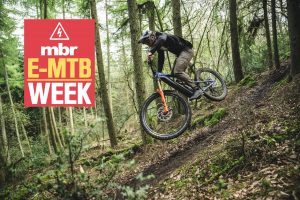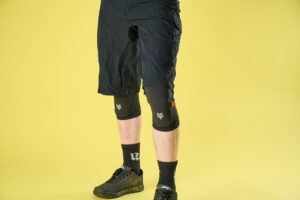Cannondale has done something special with the Moterra SL 1, and with better tyres and brakes it might have won our SL E-Bike of the Year award.
I was totally won over by the Cannondale Moterra SL’s raw power and range, but it doesn’t have the suspension response to capitalise on its extreme geometry and relatively lightweight build
The Cannondale Moterra SL truly is a hybrid bike. It shares its name, travel and Shimano EP801 motor with the full-power Moterra, but the sleek full-carbon frame has more in common with the Scalpel XC race bike than any other e-bike in the current Cannondale line-up.
– Short of time? Click here to skip to the verdict –
It’s also something of an outlier in our 2024 SL E-Bike of the Year test. It comes stock with a 601Wh integrated battery, which easily gave it the best range in test. Even in Boost mode, it managed to rack up an impressive 1,215m of vertical and 31.4km of trail in our real-world range test. And at an eye-watering pace too. More impressive still, is that our size L test bike, with our Continental control tyres fitted, weighed in at 20.44kg. So as full power e-bikes go, the Moterra SL is most definitely SL, and comparable with the best lightweight e-bikes on the market.

There’s nothing radical about the Cannondale Moterra SL’s profile, but it ticks all the boxes for a modern SL e-bike, and more.
Frame and geometry
So how did Cannondale manage to step on to the SL e-bike scale with all that muscle and zero fat. Easy, it took lessons from the lightest, fastest machines in mountain biking… the best XC race bikes. Lots of brands employ flex-stay suspension designs to great effect on XC bikes to save weight, so why not apply the exact same technology to an SL e-bike? Well, that’s exactly what Cannondale has done on the Moterra SL.

XC tech saves weight on the Moterra SL frame
By completely eliminating the chainstay pivots, common to four-bar suspension designs like on the Specialized Turbo Levo SL and Norco Fluid VLT, Cannondale was able to offset some of the extra weight associated with the full power motor to build a competitive SL e-bike. How competitive? Well the top-end Moterra SL LAB71 weighs a scant 19.7kg and our SL 1 came in at an impressive 20.44kg.

It didn’t take longe for the charging port cover to get chewed up.
MX wheels and a smaller – actually in this test, a bigger than average – 601Wh battery with high density cells also help tip the needle in the right direction. Well, at least when compared to full-power bikes with say, 750Wh batteries fitted.

An angle adjust headset offers 1.2º adjustment: Slack or super slack. You can also choose how to route your cables – thanks Cannondale!
But don’t think for a second that the XC-inspired suspension design equsls XC handling. With a seriously slack 61.9º head angle – thanks to the -1.2º headset cups fitted – and a steep 76.6º seat tube angle, the Moterra SL has the numbers to be lightning fast, both up and down hill.

Stacks of tyre clearance with the smaller 27.5in rear wheel. Rubber flap helps stop mud getting wedged where the cables run between front and rear triangles.
There are also flip chips in the rocker link that correct the geometry for a 29in rear wheel if you want to go full 29er mode. Which also explains why the chainstays aren’t particularly short for an MX bike. They are semi-size specific though: S and M are 449mm, then grow to 453mm and 458mm on the L and XL respectively.

A wolf in sheep’s clothing? Even the 61.9º head angle looks remarkably normal.
Cannondale Moterra SL 1 Need to know
- Lightweight/full power e-bike
- Full carbon frame with MX wheels
- FlexPivot suspension pumps out 150mm travel
- Fox 36 fork gets 160mm to help balance travel
- Four frame sizes, three chainstay lengths
- Shimano EP801 motor and 601Wh battery
- Proportional Response gives size-specific kinematics
- Slack 61.9º head angle with angle set adjustment
- Range 1,215m vertical
- Weight 20.44kg
- Sizes S, M, L, XL
Motor and battery
Now let’s take a look at the e-bike system on the Moterra SL. The Shimano EP801 motor delivers 85Nm torque and has a peak power output of 600 watts. That makes it considerably more pokey than the dedicated SL motors in this test, and almost double what the Trek Fuel EXe and Specialized Turbo Levo SL pump out. It also puts the Moterra SL at a slight disadvantage on the scales. At 2.7kg, the EP801 drive unit is roughly 800g heavier than the TQ motor fitted to the Trek. Given the extra power though, I think that’s a price worth paying, especially if you’re a heavier rider.

The Shimano EP801 motor delivers 85Nm of torque through the SRAM AXS drivetrain.
And just because you have all of that power at your disposal, it doesn’t mean you have to give it full beans all of the time. In fact, I found that the best option on the Moterra SL – and the Orbea Rise LT, which also has a Shimano EP801 motor – was to use Shimano’s e-tube app to tune the Trail modes to feel more like a regular SL bike. Which, in turn, dramatically increases the range. You can then slide all of the adjusters to the right in Boost mode, and reserve that for power hour blasts or crazy steep climbs.

The beefy carbon frame hides a 601Wh battery, but there’s no range extender option.
That said, it’s incredibly hard not to get sucked into using all of the power when you have it at your fingertips. Because, let’s face it, going uphill fast is super fun too. So, it’s a good thing that the Moterra SL comes with that 601Wh battery inside the down tube. The battery is fully integrated, so you can’t run a two battery setup, and there’s currently no range extender, so you’ll have to work harder or duck out early if your mates are all on full-fat e-bikes.

It’s had a hard life. Creaking cranks and a missing bold from the motor cover didn’t help our experience on this particular demo bike.
I installed the Shimano race firmware update, where the increased support and overrun completely transformed the feel of the EP801 motor. All Shimano needs to do now is eliminate the annoying rattle from the motor when coasting and it could be back in pole position ahead of the other best e-bike motors.

Having two displays on the Moterra SL proved handy when one stopped working.
In addition to the standard control switch, the power button embedded in the top tube of the Cannondale frame doubles as a basic display and controller. You can see battery life and which power mode you’re in, and even toggle between the different power modes. This belt-and-braces approach proved super handy when the handlebar remote suddenly stopped working after I washed the bike. Plainly Shimano still has some bugs to iron out.
Suspension
With the carbon FlexPivot in the exact same position on the chainstays as a traditional Horst link pivot, the 150mm rear suspension on the Moterra SL is still a genuine four-bar design. And the Proportional Response kinematics mean that the suspension design is tuned for each of the four frame sizes, so all riders, regardless of height, get similar ride characteristics.

Eliminating the chainstay bearings and hardware saves some weight, but at what cost?
With the shock loaded and sitting deeper in the travel, the 150mm rear suspension on the Moterra SL feels plush and composed. The FlexPivots also give the bike a really gentle bottom out, because they still flex a little, even when the Fox Factory Float X shock has reached the end of its stroke. I’m also convinced that the energy stored in the flexstays gives the bike its poppy, playful nature.

Fox Factory Float X and 36 Grip2 suspension offers plenty of tuning options.
The design isn’t perfect though. The rear suspension requires a pronounced amount of force to get it moving when topped out, so under heavy braking there’s a distinct lack of traction at the rear tyre. As such, it’s not as composed on the kind of terrain that the geometry and power actively encouraged me to seek out.

At full extension the FlexPivot suspension need more force to get moving again.
Up front, the Moterra SL has its travel boosted to 160mm, and when you factor in that sub 62º head angle, the extra travel helps balance vertical wheel travel front and rear, which is what actually what matters most.

Lube channels and bleed ports keep the older Grip2 Fox 36 fork buttery smooth.
The Fox 36 chassis saves approximately 250g in weight over the beefier Fox 38 and I think it offers just the right amount of flex for lighter riders. Also, I preferred the lighter touch to the damping of the older Grip 2 fork on the Cannondale to the new new GripX fork on the Orbea Rise LT.
Components
The test bike I received from Cannondale UK had done the rounds before landing with me, so it needed new pads and rotors for the Magura MT5 brakes straight off the bat. But even with the new components, the brakes still didn’t have the power I was looking for and expected from the MT5s.

The Magura MT5 brakes on our Moterra SL were simply not up to snuff.
Also, I almost had a heart attack when the breakaway design of the lever blade caused the rear brake lever to bounce out from under my fingertip on a particularly rough descent. Forcing me to waggle my fingers around in a mad panic to try and catch hold of the flapping lever and regain control of the bike.

DT Swiss XM1700 alloy rims offer a good strength-to-weight ratio
Now this is where the specification gets interesting. The Moterra SL 1 gets Maxxis EXO+ casing tyres, but the more affordable SL 2 gets the thinner casing EXO tyres to help offset some of the weight associated with the heavier parts package on the cheaper bike. It probably saves money too, but it’s a false economy on a bike that can be ridden as hard as the Moterra SL. It’s also worth noting that adding our Continental Kryptotal control tyres to the Moterra SL 1 upped the overall weight of the bike by about 200g.

Battle scars on the SRAM derailleur, but it still worked a treat.
The SRAM X0 Eagle T-type transmission never missed a beat, but there was some serious creaking sounds coming from the E*Thirteen E*Spec Plus chainset. Or maybe it was actually the motor. Either way, it did not sound healthy.

Cannondale sweats the details on the Moterra SL 1, right down to the Fizik saddle.
All of the contact points on the Moterra SL 1 are sorted though, right down to the Fizik Terra Ridon X3 saddle and Cannondale TaperRidge lock-on grips. The DT Swiss XM1700 wheels also deserve a special mention as they proved to be bomber-solid throughout the test.
Performance
With the Shimano EP801 motor pumping out 85Nm of torque and delivering 600 watts peak power, the Cannondale Moterra SL delivers a full power experience in an SL package. So while most SL e-bikes help out on the climbs, the Moterra SL gives you the power to explore new terrain.
Climbing
Now, I’m convinced that the Moterra SL was originally designed as a full 29er, then modified with flip chips and an angle adjust headset to correct the geometry for an MX set up. Not that it really matters either way, but the upside of being compatible with both wheel sizes is that the longer-than-average 453mm chainstays, combined with steep seat tube angle, and all of that grunt from the motor, mean that the Moterra SL absolutely breezes up monster climbs – at least compared to the mid-power bikes in this test.

With the Shimano EP801 motor, the Cannondale simply rockets up climbs
Traction was pretty good when climbing too, because I would be passed the initial hump in the suspension curve that I mentioned earlier. And the Race tune firmware – with the extra overrun and faster initial pick-up – not only makes it easier to get up and over obstacles and really tricky sections on steep climbs, it also made it much easier to get going again if I did happen to stall out. Get the Moterra SL in a really low gear however, and the motor – or maybe it was the chainset – started to make some really unhealthy sounds. In fact, if you watch the range test video that I made, you can hear exactly what I’m talking about.
Descending
Take one look at that 1,290mm wheelbase and it should be crystal clear that the Cannondale Moterra SL is a big bike. But having ridden it with the headset in both the steep and slack settings, I preferred the latter, as the extra 10mm in the front centre, associated with the slacker head angle, helps balance the weight distribution with the longer rear end.

Light and flickable, for a bike with such progressive geometry.
On fast, flowing singletrack the Moterra SL handles like a charm. It’s easy to pick up and plant the bike exactly where I wanted to on the trail, and the rear suspension is pretty good at isolating the rider from repeated high frequency hits. If only I could have isolated myself from the incessant rattle coming from the bike. And I’m not referring to the standard Shimano motor clatter when coasting. No, there was something in the frame, knocking like crazy and it was really annoying. I initially thought it was the battery, but after spending a day problem-solving with Cannondale, we discovered that the upper cup of the headset was damaged, and replacing it totally eliminated the annoying knocking.

On the brakes and the Cannondale Moterra SL 1 is easy to unsettle.
Ultimately though, I think the real Achilles heel on the descents is the distinct lack of traction the Moterra SL has under braking. With the suspension topped out, you have to overcome that initial resistance in the FlexPivot design to get it working again. Which results in this inconsistent slip/grip feeling at the rear tyre that destabilises the bike and is really disconcerting. So when I came flying into some sketchy, steep chute, I was always thankful of the that long, slack geometry, even if my main concern was ‘how do I get this e-bike slowed down?’. With that in mind, I’d instantly fit better brakes and super soft compound tyres to the Moterra SL, to better reflect its downhill geometry. Even if the softer tyres mean taking a hit on the range.

Cannondale’s Moterra SL is full power and lightweight. Is this the future of SL e-bikes?
Verdict
Cannondale has almost hit upon a winning formula with the Moterra SL. By packing all the punch and power of a full fat e-bike into a relatively lightweight 20.44kg package, the Moterra SL offers a three dimensional ride experience – I literally felt that I could go anywhere and do anything on this bike. It’s not quite the Holy Grail though. Both the Magura MT5 brakes and Maxxis tyres aren't up to scratch, and the FlexPivot rear suspension lacks traction under braking. Which begs the question, would the Moterra SL be even better with regular bearings and pivots in the chainstays rather than FlexPivots? My gut feeling is yes, but I’d settle for better tyres and brakes as standard.















